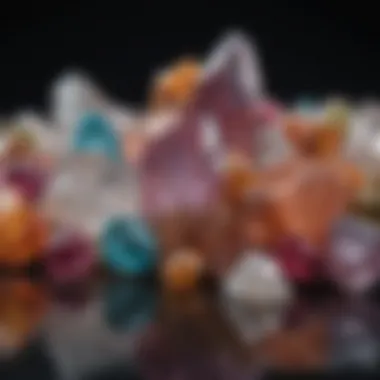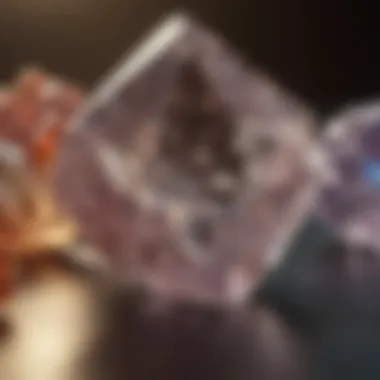Understanding Gem Quartz: Properties, Uses, and Significance


Intro
Gem quartz, a naturally occurring mineral, serves as a captivating point of interest for many enthusiasts and experts alike. Known for its exceptional versatility and aesthetic appeal, gem quartz encompasses a variety of types, each with its distinctive traits and cultural significance. This article aims to provide an in-depth exploration of gem quartz, addressing its properties, uses, and relevance in multiple contexts. From ornamental jewelry to holistic practices, gem quartz plays a pivotal role, making it essential knowledge for collectors and casual learners.
Gemstone Overview
Description of the gemstone
Gem quartz is a crystalline form of silicon dioxide. It exists in several varieties, ranging from the well-known clear quartz to amethyst, citrine, and smoky quartz. Each variant exhibits unique colors and characteristics based on its specific composition and the presence of trace elements during its formation. These minerals can be found in various geological formations, often in igneous and metamorphic rocks.
Physical properties
Gem quartz is appreciated for its hardness and durability. With a hardness rating of 7 on the Mohs scale, it is suitable for various applications, including daily wear jewelry. Its crystalline structure contributes to its luster, making it visually appealing. Additionally, quartz can be transparent, translucent, or opaque, depending on the specific type and clarity of the crystal. The refractive index varies slightly among different types, which adds to their diverse looks and charms.
- Hardness: 7 on Mohs scale
- Chemical Composition: Silicon dioxide (SiO2)
- Crystal System: Hexagonal
- Color Variations: Clear, purple (amethyst), yellow (citrine), brown (smoky)
Healing Properties
Metaphysical attributes
Many believe that gem quartz has powerful metaphysical properties. It is often used as a tool for spiritual growth and healing. It is thought to amplify energy and is frequently employed in meditation practices. The clarity of clear quartz is seen as a reflection of purity and transparency, which invites positive energy into one’s life. Moreover, different varieties are associated with specific benefits:
- Amethyst: Known for its calming and purifying effects.
- Citrine: Often referred to as the merchant's stone, associated with abundance and prosperity.
- Smoky Quartz: Grounding stone that helps with trauma and negative energy.
Common uses in holistic practices
In holistic practices, gem quartz is utilized in various ways. For instance, practitioners might incorporate quartz crystals in healing sessions, believing they enhance the flow of energy throughout the body. Other common applications include:
- Meditation: Assisting individuals in focusing their mind and promoting tranquility.
- Crystal Grids: Arranging crystals to amplify intentions and energy flow.
- Jewelry: Worn as charms for protection and well-being.
"Gem quartz serves not only as an object of beauty but also as a conduit for energy and intention, making it a significant choice for both aesthetic and spiritual endeavors."
With a rich history and practical applications across different domains, gem quartz continues to engage collectors and spiritual seekers alike. Understanding these properties can deepen appreciation for this remarkable mineral.
Prelims to Gem Quartz
Gem quartz serves as a remarkable topic that not only fascinates gemstone enthusiasts but also plays a significant role in jewelry and cultural practices. This introduction aims to outline the multifaceted nature of gem quartz and highlight its relevance in various contexts.
Many people appreciate gem quartz for its aesthetic qualities. It appears in countless designs, covering everything from minimalist to extravagant pieces. Clear quartz, amethyst, smoky quartz, and rose quartz all have unique charisma that draws attention. Furthermore, the versatility of quartz allows jewelers to experiment with techniques and settings, leading to innovative creations.
Beyond aesthetics, gem quartz also carries substantial historical and cultural significance. Ancient civilizations prized various types of quartz for their purported mystical properties. Understanding this context enhances one’s appreciation of quartz and its enduring appeal across millennia.
Additionally, gem quartz has numerous practical applications. Its durability makes it suitable for everyday wear in rings and bracelets. Beyond accessories, quartz crystals are utilized in electronics and scientific instruments due to their piezoelectric properties, showcasing their importance in technology.
Defining Quartz: Mineral Composition and Characteristics
Quartz is one of the most prevalent and significant minerals on Earth. Its fundamental role in both geological and industrial contexts cannot be overstated. Understanding quartz includes comprehension of its chemical composition, which informs its characteristics. This knowledge is critical for gem enthusiasts and jewelry designers, among others.
Chemical Structure of Quartz
Quartz is composed primarily of silicon dioxide, often represented by the chemical formula SiO₂. This simple structure underpins its diverse forms and properties. The arrangement of silicon and oxygen in a three-dimensional framework leads to a variety of forms, such as clear quartz, amethyst, and rose quartz, each distinguished by their unique color and clarity.
Silicon atoms bond with oxygen atoms to form a continuous network, creating a resilient crystal structure. This cohesion contributes to quartz being less reactive compared to other minerals, granting it stability under a range of conditions. On a molecular level, the tetrahedral unit of silicon and oxygen allows quartz to maintain its structural integrity, making it suitable for numerous applications, including electronics, optics, and jewelry.
Physical Properties of Quartz
The physical properties of quartz are equally noteworthy. It exhibits excellent hardness, ranking 7 on the Mohs scale, which makes it resistant to scratches and wear. This hardness ensures durability, enhancing its desirability in jewelry as well as other functional applications. Additionally, quartz possesses a vitreous luster, giving it an appealing shine that attracts collectors and jewelry enthusiasts.
Color variations in quartz stem from trace impurities or structural defects in the crystal lattice. For instance, the purple hue of amethyst is due to iron and other trace elements. This characteristic diversity not only makes quartz visually appealing but also enriches its metaphysical significance in various cultural contexts.
Other noteworthy physical properties include:


- Transparency: Quartz can be transparent, translucent, or opaque.
- Piezoelectric Effect: Quartz can generate electric charge under mechanical stress, which grounds its use in electronic devices.
- Thermal Resistance: Quartz can withstand a wide range of temperatures, adding to its functionality in harsh environments.
"Quartz occurs in various forms and colors, each with unique characteristics contributing to its overall allure and utility."
Types of Gem Quartz
Gem quartz is a versatile group of minerals, valued for their beauty, properties, and uses. Understanding the various types of gem quartz is critical, as it influences jewelry design, metaphysical applications, and even the appreciation of these stones. Each type has unique qualities, benefits, and considerations that appeal to different audiences, from collectors to jewelry designers. Here, we will explore the most significant types of gem quartz, emphasizing their individual characteristics and importance in various contexts.
Clear Quartz
Clear quartz, often referred to as the "master healer," is known for its clarity and ability to amplify energy. It is widely used in many applications, such as jewelry and healing. The transparency of clear quartz makes it highly desirable for decorative purposes.
Some benefits of clear quartz include:
- Energy Amplification: Enhances the effectiveness of other gemstones.
- Clarity and Focus: Helps in meditation and concentration.
It is also popular because it is readily available and priced reasonably, making it accessible for both casual buyers and collectors.
Amethyst
Amethyst is a striking purple variety of quartz, often associated with tranquility and spiritual growth. Its hue can range from pale lavender to deep violet, which adds to its allure as a gemstone. Historically, amethyst has been perceived as a powerful protector against intoxication and negative energies.
Key features of amethyst include:
- Calming Energy: Supports emotional balance and reduces stress.
- Spiritual Growth: Widely used in meditation and spiritual practices.
This gemstone is highly sought after, both in the jewelry market and among metaphysical practitioners. Its visual appeal and energetic properties enhance its significance further.
Citrine
Citrine is known for its warm yellow to yellow-brown hues. Often called the "merchant's stone," it is thought to bring prosperity and wealth. Its bright color can uplift any jewelry piece, making it a favored choice for many designers.
Benefits associated with citrine include:
- Prosperity and Abundance: Believed to attract success and financial growth.
- Joy and Energy: Promotes positivity and can boost self-esteem.
Citrine is particularly popular in the autumn season, aligning with its warm colors that resonate with the changing leaves and harvest.
Rose Quartz
Rose quartz, the stone of unconditional love, is cherished for its gentle pink hue. It symbolizes love, compassion, and emotional healing. This stone is often given as a gift to loved ones, imparting a message of care and affection.
Prominent aspects of rose quartz include:
- Emotional Healing: Aids in healing emotional wounds and trauma.
- Attracts Love: Encourages self-love and can enhance romantic relationships.
Its soft color and calming energy make rose quartz a favorite among holistic practitioners and those seeking emotional balance.
Smoky Quartz
Smoky quartz ranges in color from light brown to black and is known for its grounding properties. It is often used to absorb negative energies, making it a valuable addition to spiritual practices. Smoky quartz serves to anchor energy and provides stability.
Key attributes of smoky quartz are:
- Grounding Energy: Helps to connect with the earth and promote stability.
- Protection: Acts as a barrier against negativity, both internal and external.
This variety is often favored by those looking to enhance their meditation practices and achieve deeper levels of spiritual connection.
Understanding the unique properties and benefits of each type of gem quartz informs better choices for both personal use and making jewelry. This knowledge can elevate one's appreciation of these remarkable minerals.
The Formation of Quartz Crystals


The formation of quartz crystals is a cornerstone of understanding gem quartz. This section examines both geological processes and common locations where quartz deposits are found. Recognizing these elements is crucial for enthusiasts and collectors alike, offering insight into how quartz develops and its varied applications.
Geological Processes Involved in Quartz Formation
Quartz formation occurs through several geological processes that transform silicon dioxide into the well-known crystalline structure. This transformation takes place primarily in igneous, metamorphic, and sedimentary environments.
- Magmatic Processes: In igneous rocks, quartz can crystallize from the cooling of magma. As magma cools slowly beneath the Earth’s surface, silicon dioxide separates out, forming clear quartz crystals as the temperature decreases.
- Hydrothermal Activity: Another significant process involves hydrothermal systems. Hot, mineral-rich water can migrate through cracks in rocks. When this water cools, or the pressure decreases, quartz precipitates from the solution, often forming larger crystals in geodes.
- Metamorphism: Quartz can also form during metamorphic processes when existing rocks undergo changes due to high pressure and temperature. This allows minerals to rearrange and crystallize anew, often resulting in quartz-rich metamorphic rocks.
- Sedimentary Processes: Lastly, in sedimentary environments, quartz can develop from the weathering of other rocks. Over time, the high durability of quartz allows it to accumulate, forming sandstones or quartzites in sedimentary basins.
Common Locations of Quartz Deposits
Identifying where quartz deposits occur is essential for both gem collectors and industry professionals. Quartz is found across various geological settings around the world.
- Brazil: Known for high-quality amethyst and citrine deposits, Brazil produces significant quantities of quartz crystals for both collectors and jewelry makers.
- United States: Notable locations include Arkansas, famous for its clear quartz, and the Sierra Nevada, which produces a variety of quartz types.
- Madagascar: This island offers unique crystal formations, particularly in the form of rose quartz and smoky quartz, prized by the gemstone community.
- Switzerland: Renowned for its alpine crystals, Switzerland is often sought after for clear and smoky varieties, embodying some of the finest quartz forms in Europe.
- Germany: The regions of Bavaria and the Black Forest are known for quartz deposits associated with historical mining traditions, contributing to the European gem market.
"Quartz is one of the most abundant minerals in the Earth's crust, forming in various settings, reflecting its geological diversity."
Understanding the formation processes and locations of quartz deposits enriches our appreciation of this mineral's beauty and resilience. It serves as a vital knowledge base for gemstone enthusiasts, jewelry designers, and geologists alike.
Historical Context of Gem Quartz
The historical context of gem quartz provides essential insights into its cultural significance and evolution in craftsmanship. Understanding this context not only reveals how societies have valued quartz over time but also underscores its role in shaping human creativity and beliefs. This section aims to explore the multifaceted relationship that ancient civilizations had with quartz and how it has transitioned to modern jewelry making, enriching both historical knowledge and aesthetic practices.
Cultural Significance of Quartz in Ancient Civilizations
Quartz has been revered across various ancient cultures, often seen as more than just a decorative stone. For many, it represented clarity, strength, and healing. The ancient Egyptians, for instance, believed that quartz had protective properties. They would use smoky quartz in amulets, thinking it could ward off evil spirits. Additionally, rose quartz was not only used for jewelry but also carved into small statues, believed to attract love and compassion.
In Asia, specifically China, clear quartz has a long-standing history as a symbol of purity and wisdom. Jade and quartz were often used in ceremonial objects, indicating their importance in rituals and daily life. In some Native American cultures, quartz was considered sacred. It was utilized in healing practices and spiritual rituals, emphasizing its deep connection to nature and the belief systems of the people.
The use of quartz in these ancient societies was often intertwined with religious beliefs, indicating that it held a significant place in their cultures. The properties attributed to quartz often aligned with the values and practices of these civilizations.
The Evolution of Quartz in Jewelry Making
The transformation of how quartz is used in jewelry making reflects broader cultural and technological shifts. Initially, ancient artisans crafted simple forms, focusing on the natural beauty of the stones. However, as trade routes expanded and jewelry-making techniques advanced, the sophistication of quartz jewelry evolved significantly.
During the Renaissance period, quartz was often set in gold and intricately designed pieces, demonstrating both wealth and artistry. The clarity and brilliance of quartz made it a preferred choice among jewellers who sought to enhance their designs. The industrial revolution introduced machinery that allowed mass production, making quartz more accessible to the general public.
Today, quartz jewelry not only reflects individual artistry but also incorporates modern technologies such as cutting and polishing techniques that highlight the stone's brilliance. Various styles from minimalist to ornate designs may feature quartz prominently, showcasing its versatility.
"Quartz, in its numerous forms, continues to be an essential building block in contemporary jewelry, expertly marrying tradition with innovation."
Metaphysical Properties of Gem Quartz
Exploring the metaphysical properties of gem quartz reveals a rich tapestry of beliefs and practices. Quartz is renowned for its ability to enhance various aspects of personal growth and emotional well-being. The idea of using stones for meditation and healing is not just a passing trend; it has deep historical roots.
Gem quartz is said to resonate with the mind and body, aiding in tranquility and focus. This section discusses how people perceive these properties and how they may rely on quartz for emotional stability, energy amplification, and spiritual connection.
Healing Benefits Associated with Quartz
The healing benefits of quartz have fascinated many for centuries. Often referred to as a "master healer," quartz claims to support physical and emotional healing.
- Energy Amplification: Quartz is believed to amplify energy and intention. This property makes it a favored choice for practitioners who wish to enhance their healing practices.
- Cleansing and Balancing: Many users advocate that quartz helps to cleanse negative energy. Its role in balancing the energy fields of the body can promote overall well-being.
- Stress Relief: Some therapists incorporate quartz in stress-relief techniques, suggesting it aids in lowering anxiety levels and bringing emotional clarity.
- Focus and Clarity: Individuals often claim that holding or meditating with quartz helps them gain mental clarity. This can be especially beneficial when making important decisions.
Research into the healing benefits of quartz continues to grow. Many enthusiasts document personal experiences, adding to the lore surrounding this popular mineral.
Usage in Meditation and Spiritual Practices
Meditation practices often integrate quartz for deepening spiritual experiences. The crystal's purported energies play a significant role in various meditation techniques. Here are a few common usages:
- Enhancing Meditation: Meditating with quartz is thought to create a deeper spiritual connection. Users often place quartz near them or even hold it while meditating.
- Focus During Practice: People find that quartz helps to center their thoughts during meditation, encouraging focus and reducing distractions.
- Spiritual Growth: Many believe that quartz facilitates personal growth by enhancing insights and clarity during spiritual practices, providing guidance along the way.
"The clarity and amplification associated with quartz make it the perfect companion for anyone looking to deepen their meditation experience."


Engaging with quartz within spiritual contexts is common worldwide, reflecting its importance across diverse cultures. Overall, the metaphysical aspects of quartz resonate with those seeking healing and self-discovery.
Practical Considerations in Gem Quartz Use
Understanding gem quartz extends beyond its allure and beauty; there are significant practical considerations to acknowledge. This section focuses on identifying genuine quartz, ensuring ethical sourcing, and maintaining its condition. Collectors, jewelry designers, and geology enthusiasts alike will benefit from these insights.
Identifying Genuine Quartz
The market is flooded with synthetic and misleadingly labeled stones. Identifying genuine quartz is critical for anyone looking to invest in high-quality specimens. The primary method involves a simple visual examination. Real quartz typically shows a clear crystalline structure. If you encounter a piece that appears overly shiny without any facets, it may be a synthetic material.
Additionally, you can perform the scratch test. Genuine quartz ranks at 7 on the Mohs hardness scale. It will not scratch easily, whereas softer materials will show damage. Observing the stone's clarity is also vital; natural quartz may have minor inclusions, while synthetic counterparts often lack these imperfections. Another reliable method is the use of a refractometer to check the refractive index, which for quartz is approximately 1.54-1.55. Here are some tips to consider:
- Check for bubbles or inconsistencies under magnification.
- Look for the stone’s weight; genuine quartz feels denser than glass.
- Always acquire from reputable dealers.
Ethical Sourcing of Quartz
The conversation surrounding ethical sourcing is ever more critical in today’s jewelry industry. Many consumers recognize the importance of supporting sustainable practices. When sourcing quartz, consider whether the mining operations are fair and environmentally responsible. Unscrupulous mining can lead to detrimental environmental effects, including habitat destruction.
Research is essential. Find out if your quartz comes from countries with established mining regulations. Various organizations ensure that gemstones are mined responsibly. Look for certifications that emphasize ethical practices. Choosing to purchase ethically sourced quartz not only supports responsible mining but also contributes to the local economies and communities involved.
Care and Maintenance of Gem Quartz
Proper care and maintenance prolongs the life of gemstone quartz, ensuring it retains its beauty and durability. Fortunately, quartz is relatively low-maintenance compared to other gemstones. To maintain its luster, clean quartz with a soft, damp cloth regularly. Avoid harsh chemicals or abrasive materials that could scratch the surface.
When storing quartz, choose a soft pouch or box lined with fabric to prevent scratches caused by friction with other items. For crystals used in metaphysical practices, regular cleansing may be beneficial. This can include rinsing the stone under water or placing it in sunlight to recharge.
Key maintenance points:
- Keep away from extreme temperature changes.
- Avoid exposure to harmful chemicals.
- Regularly inspect for any signs of damage.
"Knowledge of practical considerations is essential for preserving the value and integrity of your gem quartz collection."
By being mindful of these practical aspects, you will enhance your experience with gem quartz, whether as a collector or as a designer. Informed choices lead to better investments and more responsible consumption.
Gem Quartz in Contemporary Jewelry Design
Gem quartz has established its place in contemporary jewelry design, serving as a versatile medium that allows designers to explore creativity while appealing to consumers’ tastes. The significance of gem quartz within the jewelry industry cannot be underestimated. Its diverse types, combined with a range of colors and qualities, provide abundant opportunities for artists and jewelers to create stunning pieces that resonate with personal expression and aesthetic enjoyment.
Current Trends in Quartz Jewelry
Recent trends showcase innovation in how gem quartz is utilized. One can observe an increase in the popularity of raw and uncut quartz in jewelry design. This trend reflects a broader movement towards authenticity and individuality. Consumers are drawn to unprocessed materials, appreciating the unique characteristics of each stone.
In addition, many contemporary designers are integrating quartz with sustainable practices. Using ethically-sourced materials aligns with the values of a growing number of consumers who prioritize environmental responsibility. As jewelry lovers become more conscious of their purchase, brands that market ethically-sourced gem quartz can differentiate themselves in a crowded marketplace.
Furthermore, there is a trend towards combining different types of quartz. For instance, pieces that blend amethyst, citrine, and smoky quartz create a visual narrative rich in color and meaning. This not only offers aesthetic allure but also embraces the metaphysical properties associated with each type of quartz. Jewelers are keen to highlight these properties, connecting emotional value to their designs.
Fusion of Traditional and Modern Techniques
The fusion of traditional and modern techniques is becoming a hallmark of quartz jewelry design. Many artisans draw from age-old methods, such as hand-faceting and engraving, while integrating modern technologies like laser-cutting and 3D printing.
This combination allows for intricate designs that were previously impossible to achieve. The precision of modern tools meets the sentimentality of hand-crafted practices, creating pieces that honor tradition but speak to contemporary sensibilities. For example, intricate pendants may combine classic settings with geometric shapes that are popular today.
Moreover, collaborations between artisans from different backgrounds have enriched the designs, leading to innovative aesthetics. The global exchange of styles has engendered a new wave of creativity that challenges perspectives on what jewelry can look like.
In summary, the integration of gem quartz into contemporary jewelry reflects a broader cultural shift towards sustainability, authenticity, and innovation. The focus on ethical sourcing and the merging of traditional craftsmanship with modern approaches bring compelling narratives to the pieces, enhancing their value for both wearers and collectors alike.
The End
In this article, we have explored the multifaceted nature of gem quartz. Its significance extends beyond mere aesthetics; it encompasses scientific, cultural, and practical dimensions that make it a valuable material in various fields.
Gem quartz offers a rich palette of colors and forms, making it a popular choice in both jewelry design and collectors' troves. The different types of gem quartz—like amethyst and citrine—each have unique characteristics and are appreciated for their specific beauty and properties. This variety illustrates the breadth of options available to enthusiasts and designers alike.
The historical context reveals quartz's long-standing importance in ancient civilizations. These cultures recognized its worth, attributing metaphysical properties and employing it in tools and jewelry. Understanding this history imparts a greater appreciation for gem quartz today, allowing collectors to approach their specimens with a well-rounded perspective.
From a practical standpoint, the article also underscores essential considerations regarding gem quartz. Identifying genuine pieces and ensuring ethical sourcing are vital for conscientious collectors. Additionally, proper care and maintenance extend the life and beauty of quartz, enhancing its value.
In addition, contemporary jewelry design reflects a fusion of traditional craftsmanship and modern innovation. Current trends highlight this dynamic, suggesting a continuing evolution of gem quartz's role in fashion and art.
Ultimately, understanding quartz's properties, uses, and significance enriches not just knowledge but also the experience of collecting and wearing these gemstones. Its natural allure combined with its storied past and ongoing innovation ensures that gem quartz will remain a topic of interest and value for generations to come.







